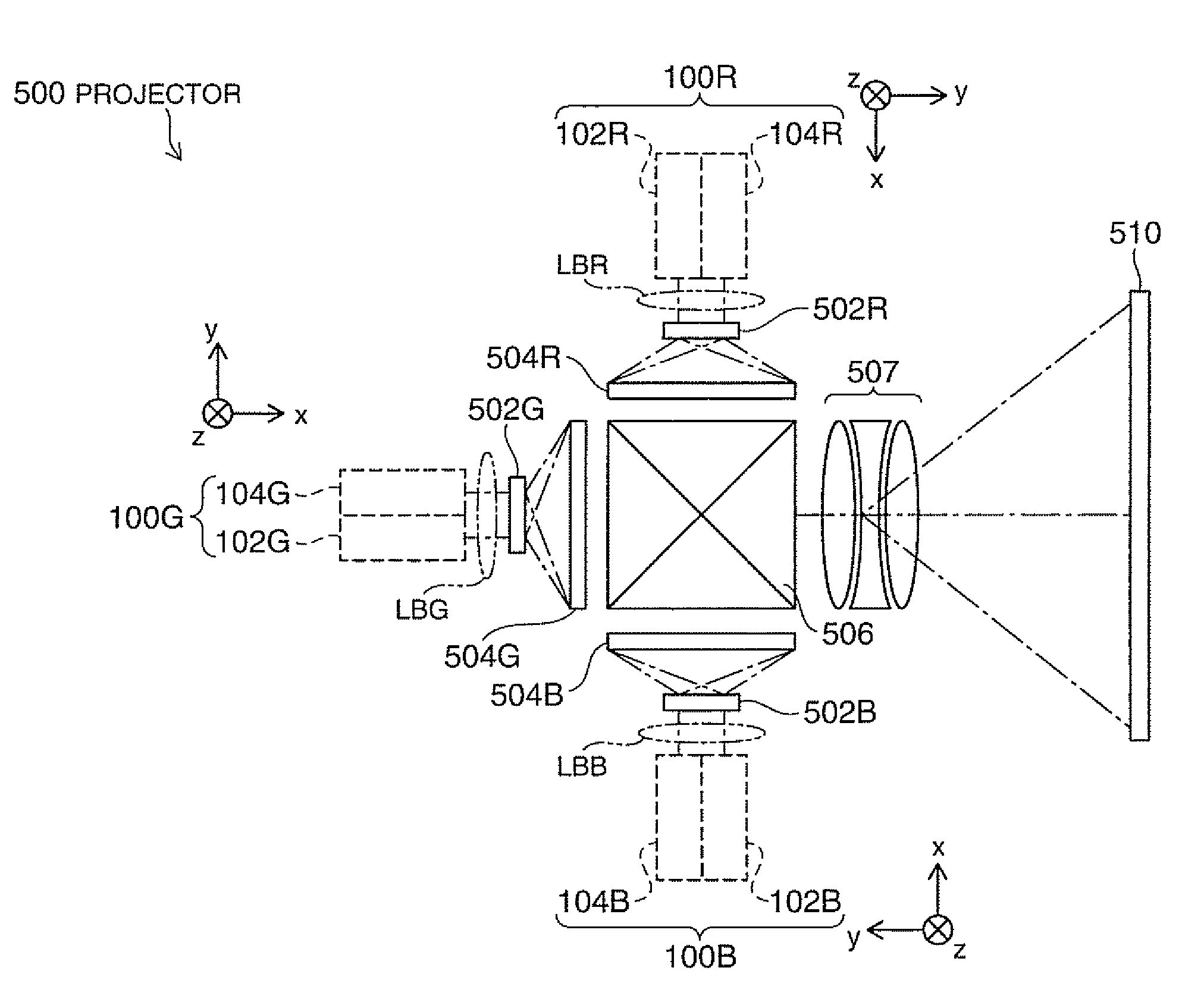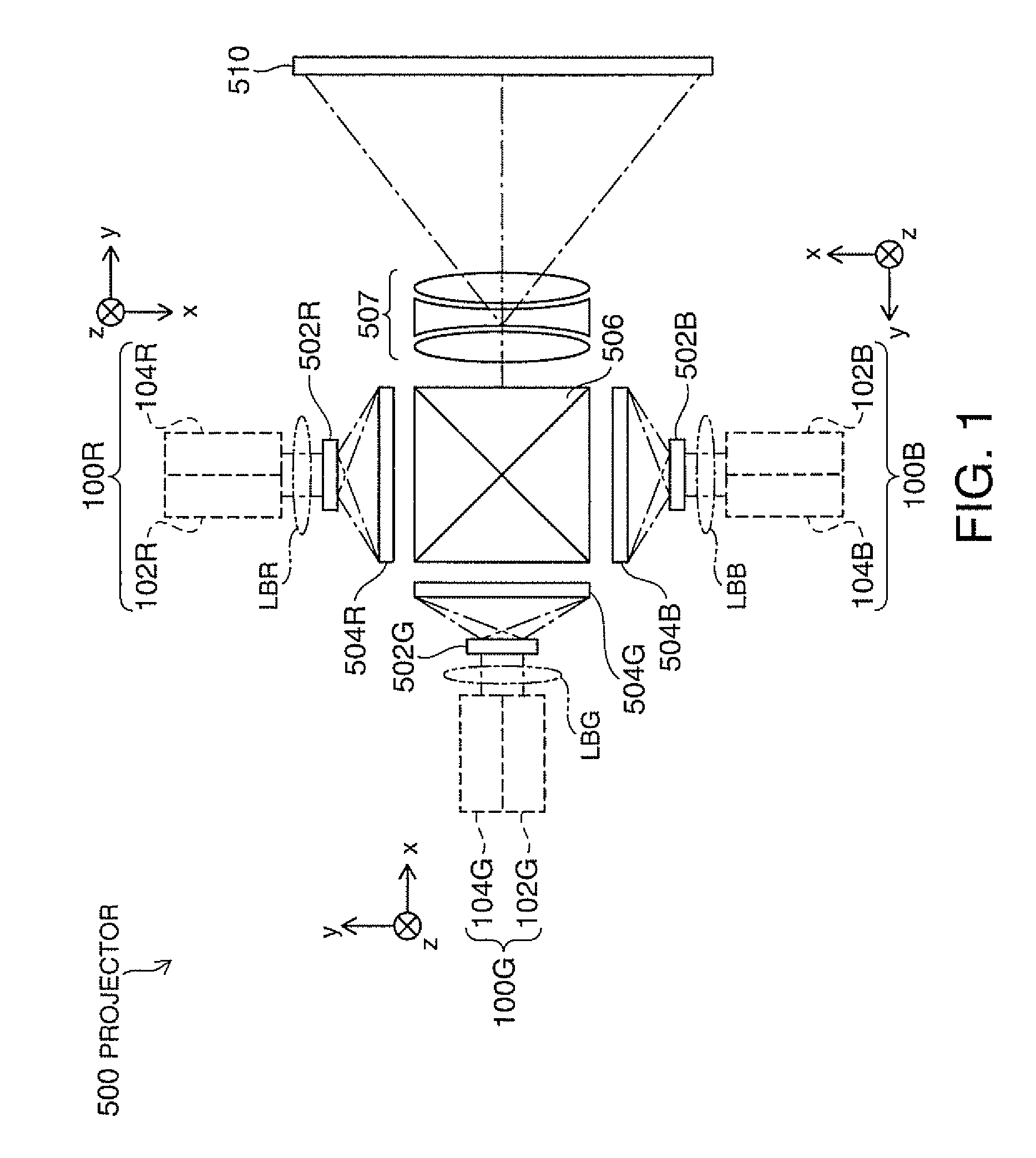Laser light source apparatus, and monitoring apparatus and image display apparatus using the same
a technology of laser light source and monitoring apparatus, applied in the direction of instruments, semiconductor lasers, optics, etc., can solve the problems of reducing the image quality of the projected image, speck noise appearing on the image projection screen, and problems not only in the light source apparatus used, so as to reduce the coherence of laser light emitted
- Summary
- Abstract
- Description
- Claims
- Application Information
AI Technical Summary
Benefits of technology
Problems solved by technology
Method used
Image
Examples
first embodiment
A. First Embodiment
[0052]FIG. 1 is a schematic configuration diagram of a projector to which a first embodiment of the invention is applied. The projector 500 includes a red light emitting laser light source apparatus 100R, a green light emitting laser light source apparatus 100G and a blue light emitting laser light source apparatus 100B. The red laser light source apparatus 100R is formed by stacking two laser array light sources 102R and 104R, each emitting red laser light. Similarly, the green laser light source apparatus 100G is formed by stacking green laser array light sources 102G and 104G, and the blue laser light source apparatus 100B is formed by stacking blue laser array light sources 102B and 104B.
[0053]The projector 500 further includes homogenizing optical systems 502R, 502G, and 502B and liquid crystal light valves 504R, 504G, and 504B for respective colors. The projector 500 further includes a cross dichroic prism 506 and a projection lens 507. The cross dichroic pr...
second embodiment
B. Second Embodiment
[0070]FIG. 4A is a configuration diagram showing the configuration of the laser light source apparatus 100a in a second embodiment. The laser light source apparatus 100a of the second embodiment differs from the laser light source apparatus 100 of the first embodiment shown in FIG. 3A in that the configuration of a first laser array light source 102a is different. Specifically, a VCSEL array 110a and a wavelength conversion element 130a differ from the VCSEL array 110 and the wavelength conversion element 130 in the first embodiment. The other components are the same as those in the first embodiment. FIG. 4B shows the positional relationship of the exit positions of the beams W14a, W24 that exit from the laser light source apparatus 100a of the second embodiment with respect to the packages 170 for the laser array light sources 102a and 104. The positional relationship is the same as that in the first embodiment shown in FIG. 3B except that the exit beam W14 is r...
third embodiment
C. Third Embodiment
[0080]FIG. 6A is a configuration diagram showing the configuration of the laser light source apparatus 100b in a third embodiment. The laser light source apparatus 100b of the third embodiment differs from the laser light source apparatus 100a of the second embodiment shown in FIG. 4A in that the wavelength conversion element in the first laser array light source 102a is replaced with the wavelength conversion element 130 of the same wavelength as the wavelength conversion element 130 in the second laser array light source 104, and in that the temperature Ts of the wavelength conversion element 130 in the first laser array light source 102a is set to 20° C. The other components are the same as those in the second embodiment.
[0081]As described above, the optical length of the domain pitch of the wavelength conversion element 130 varies with the temperature of the wavelength conversion element 130. When PPLN is used, as in the case of the third embodiment, the optim...
PUM
 Login to View More
Login to View More Abstract
Description
Claims
Application Information
 Login to View More
Login to View More - R&D
- Intellectual Property
- Life Sciences
- Materials
- Tech Scout
- Unparalleled Data Quality
- Higher Quality Content
- 60% Fewer Hallucinations
Browse by: Latest US Patents, China's latest patents, Technical Efficacy Thesaurus, Application Domain, Technology Topic, Popular Technical Reports.
© 2025 PatSnap. All rights reserved.Legal|Privacy policy|Modern Slavery Act Transparency Statement|Sitemap|About US| Contact US: help@patsnap.com



